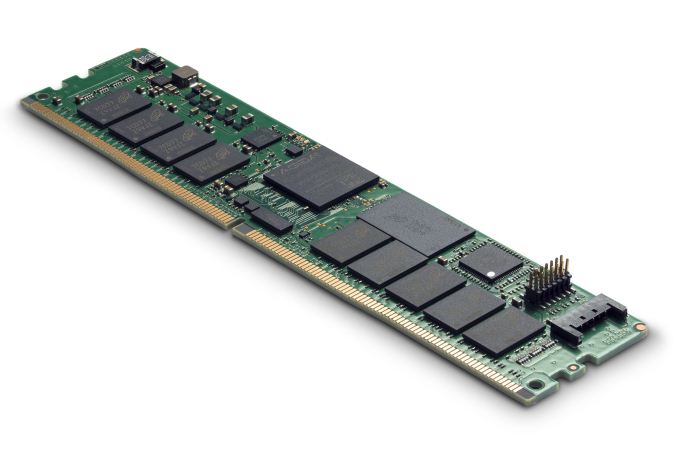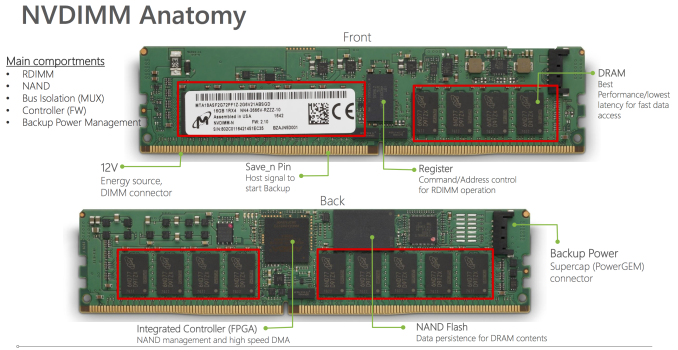Micron Announces 32GB DDR4 NVDIMM-N Modules
by Billy Tallis on November 13, 2017 9:00 AM EST
Micron is announcing today their next generation of NVDIMM-N modules combining DDR4 DRAM with NAND flash memory to support persistent memory usage models. The new 32GB modules double the capacity of Micron's previous NVDIMMs and boost the speed rating to DDR4-2933 CL21, faster than what current server platforms support.
Micron is not new to the Non-Volatile DIMM market: their first DDR3 NVDIMMs predated JEDEC standardization. The new 32GB modules were preceded by 8GB and 16GB DDR4 NVDIMMs. Micron's NVDIMMs are type N, meaning they function as ordinary ECC DRAM DIMMs but have NAND flash to backup data to in the event of a power loss. This is in contrast to the NVDIMM-F type that offers pure flash storage. During normal system operation, Micron's NVDIMMs use only the DRAM. When the system experiences a power failure or signals that one is imminent, the module's onboard FPGA-based takes over to manage saving the contents of the DRAM to the module's 64GB of SLC NAND flash. During a power failure, the module can be powered either through a cable to an external AGIGA PowerGEM capacitor module, or by battery backup supplied through the DIMM slot's 12V pins.
Micron says the most common use cases for their NVDIMMs are for high-performance journalling and log storage for databases and filesystems. In these applications, a 2S server will typically be equipped with a total of about 64GB of NVDIMMs, so the new Micron 32GB modules allow these systems to use just a single NVDIMM per CPU, leaving more slots free for traditional RDIMMs. Both operating systems and applications need special support for persistent memory provided by NVDIMMs: the OS to handle restoring saved state after a power failure, and applications to manage what portions of their memory should be allocated from the persistent portion of the overall memory pool. This can be addressed either through applications using block storage APIs to access the NVDIMM's memory, or through direct memory mapping.
Micron is currently sampling the new 32GB NVDIMMs but did not state when they will be available in volume.
Conspicuously absent from Micron's announcement today is any mention of the third kind of memory they make: 3D XPoint non-volatile memory. Micron will eventually be putting 3D XPoint memory onto DIMMs and into SSDs under their QuantX brand, but so far they have been lagging far behind Intel in announcing and shipping specific products. NVDIMMs based on 3D XPoint memory may not match the performance of DRAM modules or these NVDIMM-N modules, but they will offer higher storage density at a much lower cost and without the hassle of external batteries or capacitor banks. Until those are ready, Micron is smart to nurture the NVDIMM ecosystem with their DRAM+flash solutions.
Source: Micron











48 Comments
View All Comments
Hereiam2005 - Monday, November 13, 2017 - link
1) The SN260 tops out at 2.2GBps write speed. Check your .2) The last thing you'd want to do after spending 100k$ on RAM is to spend another 100k$ on SSD that you don't need.
3) The whole point of in-memory database is the fact that it might be updating more frequently than what an array of SSD can handle. Something like high frequency trading. So no flushing, unfortunately.
4) There's redundancy, in case of component failure. Still redundancy can only do so much.
5) RAM fails far less frequently than PSU and other electronics.
6) Yeah, power backup solution is bulky and fail often, even when not in use. If your machine fail and your generator/psu fail on you too, you are SOL.
7) If you flush the content of RAM into SSDs, you have to keep the entire system online. That's 1000 watts per node. If you flush on an NVDIMM, you only need to keep the dimms alive - 5 watts per DIMM at most, or about 150W per 32 DIMM system. That's why small supercaps are sufficient. There are many NVDIMM solutions that are self contained within a single node - that is not something you can do with power backup/generator solutions.
8)NVDIMMs/supercapacitors is far more compact and reliable than PSU/power generator solution, less power hungry and less expensive than SSD solution. What more do you want?
I get it, it is pointless to you. Don't extrapolate that to everybody else, please.
Hereiam2005 - Monday, November 13, 2017 - link
I forgot to add, the time to flush the content of a NVDIMM to the on dimm ssd is about 40 sec. Which is constant no matter how much RAM you have. And that is just the baseline, which will be improved with better NVDIMM in the future, without having to change the underlying hardware.With SSD the write speed peaks around 2 GB/s, and is generally capped by the speed of the PCIE itself - that's why I used a generous 3GB/s figure for an imaginary SSD that is not yet on the market.
FullmetalTitan - Thursday, November 16, 2017 - link
Petition to ban this flame war starting idiot. He willingly misses the point of EVERY SINGLE PRODUCT REVIEW, just to start fights with people who have 100x the industry/application knowledge as him on VERY niche products. His contributions to this discussion (as with all others) are nothing but negativity and distractionvanilla_gorilla - Monday, November 13, 2017 - link
Serious question: how much and when could this be used as primary storage (i.e., boot from it) ?DanNeely - Monday, November 13, 2017 - link
What's the jumper block for? The way it's positioned unless you put a single NVdimm in each block of slots it's going to prevent using an adjacent slot or two.ddriver - Monday, November 13, 2017 - link
It is probably just for debugging prototypes.Elstar - Monday, November 13, 2017 - link
Yup. If one looks closely, the jumper block is missing from from the "anatomy" diagram.iwod - Monday, November 13, 2017 - link
I am much more interested to see larger Memory per stick, and much lower pricing.While we have In-Memory computing taking off, the price for Memory is still very high.
kolbryn - Monday, November 13, 2017 - link
Please note this solution is not for consumer/prosumer market. This is for a very specific use case. For an enterprise spending $1M+ for a storage solution these DIMMs will actually reduce the cost of the hardware and/or provide additional protection from a service processor power failure.PeachNCream - Monday, November 13, 2017 - link
It almost looks like Micron is preemptively working to build up the hardware and software ecosystem needed to support XPoint DIMMs in the future. That's probably a smart idea since NV sorts of RAM are peeking up over the horizon (had to read up on this stuff to learn a little more about it and it looks like one of the biggest potential changes to modern computing we've had in a while). It'd be a surprise if we didn't see XPoint DIMMs before the end of next year.